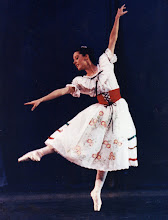
Ballet teachers have a unique opportunity to instill self confidence and to encourage creative expression in their ballet students. The task should never be taken lightly, and it's important for parents of young children to fully investigate the qualifications of their child's prospective teachers before beginning lessons. There are two sides of this coin: it can be looked at from the teacher's point of view as well as from the parent's point of view. This post will focus on the teacher, and how his or her classroom environment can affect the development of a child. In general, all teachers are aware of the influence they may have over impressionable children, but I believe that a ballet teacher's influence is ever so slightly different than that of a school teacher's. The ballet class is a place where the child is forced to look upon their bodies in a mirror and scrutinize that reflection. How much emphasis is placed on that image should be relative to the age of the student.
Ideally, children who begin pre-ballet or creative movement at around four years of age will not need to think too much about technique. At this stage, instilling a joy of movement is vital. Teaching musicality and approaches to moving creatively will be the main focus. Simple stretching exercises in the guise of games will be introduced. This is a very special age and quite fun to teach. Having colorful and flowing scarves, various types of musical instruments, and other props in your arsenal helps keep a child of this age engaged. Experimenting without using particular steps, but with movements that are heavy, soft, light, sharp, dull, long, short, or what have you will enable them to express themselves using their bodies in new ways. Later, when more formal technique is introduced, they will be more open to trying new things if they’ve been given a chance to experiment on their own a bit first.
Skipping ahead now to the pre-teen and teenage years, I think it’s especially important for a teacher to understand what is happening developmentally, emotionally, and intellectually to these students. This is a critical age (between 11 and 15) where they are coming into their own selves, learning how they are the same and different from their peers, and beginning to shape who they will be as adults. This is a fascinating article about the growth of the brain in these formative years, and how physical activity can have an effect on that growth.
Socially, we know that adolescents are going through a difficult time at this stage. They are morphing out of the childhood phase and moving into the adult phase, having to navigate their way sometimes alone and sometimes with the help of peers, and sometimes they are lucky enough to have the loving guidance of a teacher helping them along this new territory. I think ballet teachers could easily forget this is happening. I’m not saying that we should relax our standards by any means; I think the fact that there are clear expectations in a ballet class (see my post on ballet etiquette) can be comforting to a pre-teen. Here is a place they can come and know exactly how to behave. I’m just saying that it’s important for teachers to be aware of what these kids are going through developmentally at this stage in their lives.
One way we can effect a positive influence on pre-teens through ballet is by offering plenty of praise when they get things right. At this age students should already understand that getting a correction is not a criticism for them to take personally and feel badly about. They should know that getting a correction means they are worthy of the attention of the teacher and it’s a means to improve their technique. For a teacher, I think once a correction has been given to a student it is of vital importance to note when that student incorporates it and makes the adjustment. It’s a two-part thing here: give a correction, and watch to see (and praise) when the correction has been made in the future by that same student. This sort of confirmation encourages the student to seek corrections, even when not given to them directly, and implement the improvements in their technique because they know that the effort will be noticed.
I’m not really finished with my thoughts on the powerful influence a ballet teacher can have on his or her students, but this is enough for one post. Any other thoughts from other teachers out there? I plan to write more in detail about how we can work with kids at various stages of their training to get the most out of them, avoid burn out, and build their self esteem right along with their technique. Even for those who study ballet for a year and never come back, it can have a positive influence on their lives.
Classical Ballet: Combinations for Ten Complete Advanced Classes
by Tamara Stanwood, 2009





I have taught ballet for many years, however until last year, it was usually the advanced levels I taught. For the last year (and into my second now), I have been teaching preteens and young teens primarily and it is clear how impressionable they are. I adore this age group: they are so open and nonjudgemental and the competition between them is still playful and and friendly.
ReplyDeleteThank you for your post. I really enjoy your blog.
Laurie LeBlanc-Rickaby
http://madebyswirlygirl.blogspot.com
Thank you, Laurie. This was my favorite age to teach as well, for the same reasons you mentioned. They have an innocence about them and they try so hard to please. Thanks for including your blog URL; I'm going to check it out now!
ReplyDelete